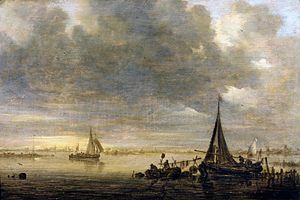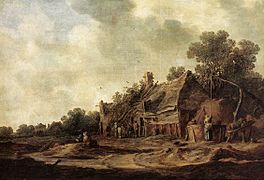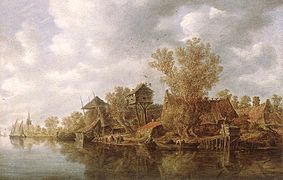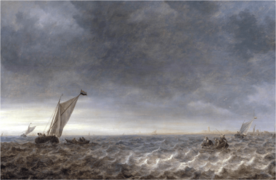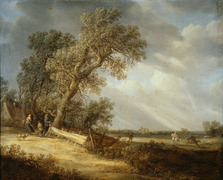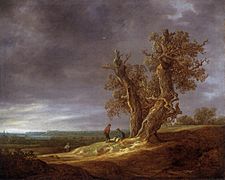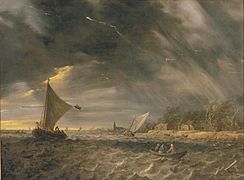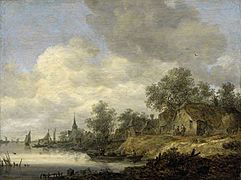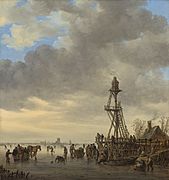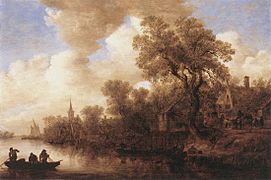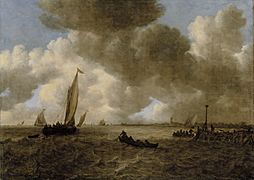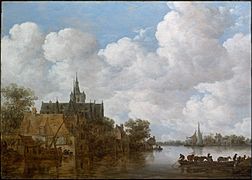Jan van Goyen facts for kids
Quick facts for kids
Jan van Goyen
|
|
|---|---|

Portrait of Jan von Goyen by Gerard ter Borch
|
|
| Born |
Jan Josephszoon van Goyen
13 January 1596 |
| Died | 27 April 1656 (aged 60) The Hague, Dutch Republic
|
| Education | Esaias van de Velde |
| Known for | Landscape painting |
| Movement | Dutch Golden Age |
Jan Josephszoon van Goyen (born January 13, 1596 – died April 27, 1656) was a famous Dutch landscape painter. He painted many different types of outdoor scenes. These included forests, rivers, beaches, and even city views. He also painted winter scenes and landscapes with farmers.
Jan van Goyen was a very busy artist. He created about 1,200 paintings and over 1,000 drawings. Many other painters were inspired by his work.
Contents
About Jan van Goyen
Jan van Goyen was born in Leiden, a town in the Dutch Republic. His father was a shoemaker. Jan started learning about art as a young helper, called an apprentice. Like many Dutch artists of his time, he studied painting in the town of Haarlem. He learned from a painter named Esaias van de Velde.
When he was 35, Jan van Goyen set up his own art studio in The Hague. His landscape paintings usually did not sell for a lot of money. So, he painted many pictures quickly. He used a small number of colors that were not expensive.
Jan van Goyen always looked for more ways to earn money. He also worked as an art dealer and helped with art auctions. He even tried investing in tulips and real estate. However, these investments caused him to have many debts. The famous painter Paulus Potter even rented one of his houses.
Jan van Goyen had a workshop where he taught students. Some of his known students were Nicolaes van Berchem, Jan Steen, and Adriaen van der Kabel. Many other painters were also influenced by his style.
In his later years, Jan van Goyen faced financial problems. In 1652 and 1654, he had to sell his collection of paintings and drawings. He then moved to a smaller house. He passed away in 1656 in The Hague. He still had a lot of debt when he died. This meant his wife had to sell their remaining furniture and paintings. His financial struggles might have also affected his student and son-in-law, Jan Steen.
Dutch Landscape Painting
In the 1600s, Dutch painters often focused on one type of art. They might paint portraits of people, landscapes (outdoor scenes), still-lifes (pictures of objects), or genre scenes. Genre scenes showed everyday life. It was rare for an artist to be great at more than one type of painting.
Jan van Goyen was mainly a landscape artist. He also liked to include scenes of everyday life in his paintings. He painted many canals in and around The Hague. He also painted the countryside near towns like Delft, Rotterdam, Leiden, and Gouda.
Other well-known Dutch landscape painters from that time included Jacob van Ruisdael, Aelbert Cuyp, and Meindert Hobbema.
Jan van Goyen's Painting Style
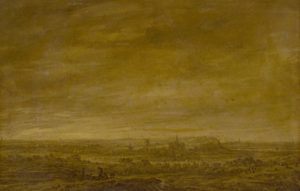
Jan van Goyen usually started his paintings on thin oak wood panels. First, he would put several layers of thin animal glue on the wood. Then, he would scrape a thin layer of tinted white paint over the whole surface. This layer, called a "ground," helped fill in any low spots on the panel. The ground was often light brown, reddish, or yellowish.
Next, van Goyen would quickly sketch the scene with a pen and ink. He didn't add small details at this stage. You can sometimes see these ink drawings in parts of his paintings where the paint is thin. He would use detailed drawings he made outdoors as a guide. These drawings were kept in his studio for reference. Back then, drawings were not usually seen as artworks on their own.
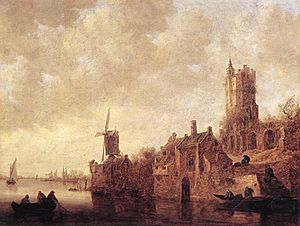
For his colors, he used shades of gray, brown, and earthy greens. These colors looked like they came from the very soil he painted. He mixed his powdered colors with a special oil medium. This helped him apply thin layers of paint that he could easily blend together.
He kept the dark parts of his paintings very thin and see-through. This allowed the light to be absorbed into the painting's ground. The lighter parts of the painting were thicker and more solid. He mixed a lot of white paint into these areas. Light hitting these parts would reflect back to the viewer. This technique made his paintings look very real and three-dimensional. The surface of his finished paintings looked soft and smooth.
Art historian H. U. Beck said that Jan van Goyen's seascapes from the 1650s were especially perfect. Some of his works can be seen at the Thyssen Bornemisza Museum in Madrid, Spain.
Jan van Goyen's Legacy
Jan van Goyen had a big impact on other landscape painters of his time. Many artists copied his way of using colors and light, which is called his "tonal quality." The Netherlands Institute for Art History says he influenced painters like Herman Saftleven and Abraham van Beijeren.
The famous painter Vincent van Gogh even mentioned Jan van Goyen in one of his letters. Van Gogh wrote about seeing a landscape from his window that reminded him of Van Goyen's style.
Gallery
-
Landscape with Two Oaks (1641), oil on canvas, 88.5 x 110.5 cm., Rijksmuseum
-
A Windmill by a River (1642), oil on panel, 29,4 x 36,3 cm., National Gallery
-
Ice Scene near a Wooden Observation Tower (1646), oil on panel, 36.5 × 34.3 cm., National Gallery of Art
-
Panorama Landscape with a View of Arnhem (1646), oil on canvas, 98.5 x 135 cm., Museum Kunstpalast
-
View of The Hague from the Northwest (1647), oil on panel, 66 x 96.2 cm., Metropolitan Museum of Art
-
River Landscape with Boats and Cottages on the Bank (1648), oil on panel, 54 x 73.7 cm., Museum of Fine Arts, Boston
-
River Landscape with a Ferry and a Church (ca. 1656), oil on panel, 47.3 x 66.7 cm., Museum of Fine Arts, Boston
See also
 In Spanish: Jan van Goyen para niños
In Spanish: Jan van Goyen para niños


